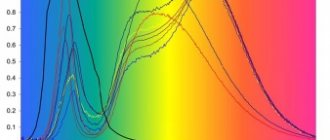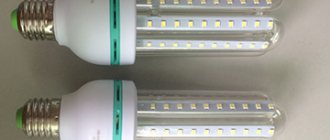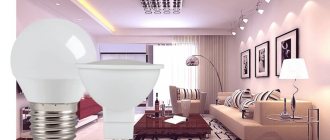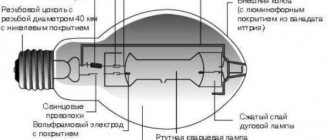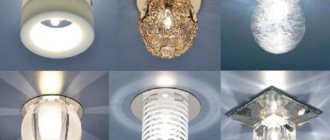Scope of use
Fluorescent lamps are common and economical light sources that create diffuse lighting in public spaces. They are used in offices, schools, hospitals, shops and banks. With the advent of compact lamps, which are installed in standard E27 or E14 sockets instead of incandescent lamps, they have become in demand in domestic conditions.
Using ballasts instead of conventional electromagnetic devices improves the performance of lamps - helping to eliminate flicker and hum, and also increase efficiency. Fluorescent light bulbs have high luminous efficiency and long operating time.
The principle of operation of energy-saving lamps
The popularity of energy-saving lamps continues to increase, although their cost is much higher than the incandescent lamps we are used to. This is due to their high reliability, long-term efficiency and quality of lighting. However, it is also said that such light sources are dangerous. Let's try to figure out whether energy-saving lamps are harmful to human health.
The design of lamps of this type is a glass tube filled with mercury vapor, on the inner walls of which a layer of phosphor is applied. When an electric current is applied, mercury vapor glows with ultraviolet light, which is converted by a phosphor layer into the part of the spectrum visible to humans.
The operation of all energy-saving lamps is based on the same principle, although we can see different types of devices that differ in shape.
Buyers prefer energy-saving lamps for the following main reasons:
- There is a reduction in electricity consumption.
- The luminous flux increases (about 5 times).
The leadership in popularity belongs to compact fluorescent lamps. These products do not pose a danger to consumers if they have a high-quality protective coating, an integral design and are manufactured in compliance with all technological requirements. However, using damaged or low-quality lamps can be harmful to health.
Pros of lamps
For those who want to save on electricity, it is important to know about the benefits and harms of fluorescent lamps. The main advantage is considered to be a reduction in energy costs, which are constantly becoming more expensive. Professionals have even carried out experiments regarding consumption of 80% less than with incandescent light bulbs.
Another advantage is durability. The product costs about 5 times more, but will last 10-12 times longer. This is beneficial, but each person must decide for himself whether to take it or not. But the health hazards from fluorescent lamps should also be taken into account.
Lamp arrangement
Compact fluorescent lamps are often called energy-saving, but this is incorrect. Lighting the room with LEDs also significantly reduces electrical energy consumption. Let's consider the principles of operation of these two varieties.
Fluorescent lamps
An incandescent lamp emits light due to the action of an electrical discharge on a tungsten filament. Fluorescent light sources are tripled in a slightly different way: electricity passes through gas, due to which an ultraviolet glow is formed. Its rays cause the phosphor applied to the walls of the lighting device to shine. Mercury is used as a gas-forming substance.
Everyone knows that this element of the periodic table is dangerous for humans when evaporated.
In office premises, everyone is accustomed to seeing tube fluorescent fluorescent lamps. In order to protect people, they are filled not with mercury, but with its amalgam. If the lamp is damaged, then people staying indoors will not be at risk of poisoning from toxic fumes.
LED lamps
Unlike fluorescent lamps, LED lamps do not use substances containing mercury. These are the most environmentally friendly light sources. The LED lamp design includes a standard base, a board with LEDs and a driver for reducing the voltage in the network.
Such light sources can be considered completely safe, if not for one “but”: workmanship. Some manufacturers save on materials, in particular on plastic. In addition, sometimes lead, phenol and formaldehyde resins are used in the manufacture of LED lamps.
Cancer
As scientists from the USA have established, the concentration of ultraviolet radiation from a light bulb is harmful to human health. This negatively affects the skin, leading to early aging, and sometimes to melanoma and skin cancer. Manufacturers of such products believe that ultraviolet radiation is generated during operation, but believe that the radiation is normal.
But as can be seen from the research results, the coating of the product has many microcracks, which increase the dose of ultraviolet radiation. In addition to cancer, the following are likely to occur:
- Allergies.
- Eczema.
- Psoriasis.
- Tissue swelling.
According to medical experts, the use of such light bulbs can lead to attacks of epilepsy, migraines, and deterioration of tone. Currently, two types of products are used: collagen and fluorescent. The second type is more harmful. Do not use 100 watt fluorescent lamps. If there are such light sources, then they must be replaced with lower power.
Energy saving lamps are harmful
Energy-saving lamps, whose harm is significantly higher than that of a conventional incandescent lamp, are used everywhere today. The reason for such a sharp popularity of energy-saving lamps is efficiency, but it is also accompanied by significant harm, which sellers and developers either keep silent about or greatly underestimate.
Energy saving lamp device
ENERGY SAVING LAMP (COMPACT FLUORESCENT LAMP)
A low-pressure gas-discharge lamp in which the main flow of light is generated by a phosphor deposited on the inner wall of the lamp. It has the shape of a tube, rolled into a spiral or snake, filled with mercury vapor and the inert gas argon.
Mercury vapor, under the influence of an electric discharge, begins to emit ultraviolet rays, which in turn cause the phosphor applied to the walls of the tube to emit light. Has significantly greater light output compared to incandescent lamps.
Energy-saving fluorescent lamps are equipped with a soft start system (EPG), as a result of which the lamp lights up gradually.
Energy-saving and fluorescent lamps are not the same thing
Energy-saving fluorescent lamps are often confused with standard tube fluorescent lamps of the linear type (in which mercury amalgam is introduced instead of mercury to avoid the possibility of contamination by mercury vapor in the room when the lamp is destroyed), used primarily in offices.
Harm
Energy-saving lamps are harmful to health
High cost compared to traditional incandescent lamps.
Short service life in domestic use. The service life declared by manufacturers (up to 10-15 thousand hours) does not correspond to reality in real conditions of domestic use - with unstable mains voltage and an intermittent operating cycle of short-term switching on (turn on - turn off).
At a low temperature range, the luminous flux drops (approximately 2 times for every −10˚C). Some of these lamps do not light up at low temperatures. At elevated temperatures, the intensity of their light radiation decreases.
Incorrect color rendering increases eye fatigue
If the voltage changes, the lamp may fail. If the voltage is low (more than 10%), the lamp may not light up. At increased voltage, especially pulsed, it fails.
A linear spectrum leads to incorrect color rendering and increased eye fatigue.
Due to the high level of ultraviolet radiation from energy-saving lamps, a person can be no closer than 30 centimeters from them. Energy-saving lamps can be particularly harmful to people with extremely sensitive skin (especially infants). Because of such light bulbs, they may develop:
- Rash
- Eczema
- Psoriasis
- Swelling on the skin
Sensitive people are not recommended to use energy-saving lamps with a power of more than 22 watts in residential areas.
High levels of ultraviolet radiation can harm the skin
The electronic ballast built into the lamp creates electromagnetic radiation - electrosmog. Some sources recommend maintaining a minimum distance of 50 cm between the lamp and your head. Therefore, it is undesirable to use them in lamps and children's rooms. Although the electromagnetic field is not significant, the body reacts to such an impact as an unfavorable environmental factor, which forces it to additionally adapt, spending vital resources. Constant such exposure leads to a decrease in immunity and can be a catalyst for diseases, primarily of the central nervous and immune systems, possibly cardiovascular.
If an energy-saving lamp breaks
Each energy-saving lamp is harmful in case of damage because it contains 3-5 mg of mercury in its bulb, the dose is insignificant, but is in the form of odorless vapor - if the bulb is damaged, mercury vapor quickly spreads through the air and when contaminated air is inhaled, it most easily enters the human body, causing severe poisoning.
If you break an energy-saving lamp in an unventilated room, the concentration of mercury in the air can be 0.05 mg/m3 for several hours. m, which exceeds the maximum permissible concentration by more than 160 times. If this happens, it is necessary to immediately and thoroughly (within half an hour) ventilate the room.
The bulb of an energy-saving lamp contains 3-5 mg of mercury
Benefit
Advantages of energy saving lamps
Long service life in continuous glow mode - from 6 to 15 thousand hours, which is 10-20 times higher than the average incandescent lamps.
Low electricity consumption - the load on the network is also reduced, and this reduces the risk of interruptions and short circuits. A conventional incandescent lamp converts 92-94% of electricity into heat and only 6-8% into light, while a compact fluorescent (energy-saving) lamp, giving the same luminous flux, consumes 80% less electricity.
Energy saving lamp saves up to 80% of electricity
Factory warranty (six months - one year) for energy-saving fluorescent lamps.
Energy-saving lamps practically do not heat up (only up to 50-60 degrees). You won't get a burn on your hands from them (like, for example, from an incandescent lamp).
Recommendations
Use LED or halogen lamps
If the instructions are followed, energy-saving fluorescent lamps are more durable and economical than incandescent lamps, however, the use of these lamps is justified only in organizations and enterprises where it is easier to control and organize the collection and disposal of energy-saving lamps.
LED lamps save energy and are not harmful to health
It is highly undesirable to use energy-saving lamps in domestic conditions. It is better to find an alternative to them, for example, safer and more energy-saving LED or halogen lamps, which are actively used in European countries.
Proper disposal of energy-saving lamps
Under no circumstances should you throw mercury-containing lamps and devices into sewers, trash containers, or just onto the street, to avoid increasing the mercury content in the air, water, and soil.
To dispose of mercury-containing lamps, you need to contact DEZ or REU
Regarding the disposal of mercury-containing lamps, you should contact the DEZ or REU, where special containers for mercury-containing waste should be installed for them.
Poisoning
The dangers of fluorescent lamps are associated with the presence of mercury. During the manufacture of products, a phosphor, argon gas with mercury vapor is used. Great harm is expected from a broken fluorescent lamp, since indoors the indicator of these components will exceed the norm.
Risk areas for mercury poisoning include:
- Pregnant women.
- Babies.
- Small children.
- Old men.
If a fluorescent lamp breaks, there will be severe harm to human health. In this case, it is necessary for a special service to handle waste disposal. And for people who were in the room, you need to call a doctor.
Myth number one
It is believed that energy-saving fluorescent light sources emit ultraviolet radiation that is harmful to humans. Is this really true? Let's start with the fact that sunlight is a vital source that has a beneficial effect on the metabolism inside the human body. In addition, everyone knows that daylight consists of two types of radiation: infrared and ultraviolet. So, let’s immediately note that incandescent lamps emit only thermal infrared rays; there is no ultraviolet in their radiation.
That is, it turns out that a person who spends a large amount of time indoors, where ordinary incandescent lamps are installed, does not receive enough ultraviolet radiation. Therefore, energy-saving types are better in this regard. It is obvious. As confirmation of all that has been said, we can recall that back in Soviet times, special ultraviolet lamps were installed in livestock complexes in winter. This made it possible to maintain the health of cows, increase their milk yield and weight gain. Back in those days, scientists proved that without the ultraviolet spectrum of light, all living things would face gradual extinction.
Of course, excess radiation cannot lead to anything good. A person who falls under it will suffer from skin and eye problems. But fluorescent energy-saving lamps emit a tiny dose that cannot harm living organisms. Testing has shown that being in a room with an energy-saving fluorescent lamp for eight hours is the same as being in the sun for an hour. That is, no harm. Of course, the lamp illumination indicator was taken into account, which was equal to 1000 lux.
So, this myth has long been dispelled, it’s just that not everyone has heard about it. And if we summarize all of the above, we can say that the ultraviolet radiation emitted by the lamp is only useful for people. And the whole point is that this radiation is released in small doses. So there's no reason to worry.
Radiation
The harm of a fluorescent lamp lies in electromagnetic radiation, which distinguishes it from a conventional incandescent light bulb. The permissible radiation limit is violated within a radius of 15 cm from the light source. Therefore, they should not be used in table and wall lamps, near which you have to stay for a long time.
The electromagnetic field is active when the light bulb is operating, which can lead to the appearance of:
- CNS disorders.
- Suppression of immune defense.
- Diseases of the heart and blood vessels.
Waves can complement other negative environmental factors, so they are harmful to health. With them, “dormant” chronic diseases awaken and protection against viral infections decreases.
Harm from energy-saving lamps
As soon as energy-saving light bulbs appeared on store shelves, they immediately attracted the attention of consumers. Significant savings in electrical energy is a worthy argument in favor of such light sources, but there is also a downside to the coin. The harmful effects of fluorescent and LED lamps are as follows:
Electromagnetic radiation
The harm from it does not pose any danger to human life.
Nevertheless, experts say that if you count the number of constantly operating electrical appliances located in the room and add up all the indicators, you get an impressive figure.
If you compare a regular incandescent lamp and an energy-saving light bulb, the radio frequency field will be detected in the second one. This does not mean that such lamps cannot be used, but you should remember the following:
- It is not recommended to place an energy-saving lamp near a bed or screw it into a table lamp. Within a radius of 15 cm, the radiation intensity increases, so it is better to hang such lighting fixtures near the ceiling.
- A small electromagnetic field cannot result in a serious illness, but it is one of the risk factors. For diseases of the cardiovascular and nervous systems, it is better to limit such exposure.
- Doctors are sounding the alarm about the use of multiple points of light with energy-saving lamps in children's rooms and bedrooms. Even small amounts of radiation gradually suppress the immune system. As a result, chronic ailments worsen and the body's resistance to respiratory infections decreases.
Interference in the electrical network
As for fluorescent lighting fixtures, they are not designed to be constantly turned on and off.
At first, they were used to illuminate public places, where they burned continuously - only in this case, savings were ensured.
When an energy-saving lamp turns on, it puts an additional load on the power grid. The voltage begins to change with high intensity, which can lead to a short circuit and failure of several home appliances. This does not apply to LED lamps: when using them, the network is not “contaminated”.
Effect on vision
Fluorescent lamps are known to be harmful to the eyes. This applies to light sources with LEDs. The reason for this is that the "daylight" light waves appear due to the use of blue and yellow diode. Blue radiation is harmful to the eyes and affects the retina. The risk zone includes:
- Children, because they are sensitive to the effects on the eyes of energy-saving devices. They do not have a formed crystal of the eyeball, and therefore there is no protection from ultraviolet radiation.
- Persons with macular degeneration.
- People during drug treatment.
Operating principle and health effects of fluorescent lamps
The flask of such a device contains argon gas and mercury vapor, which, under the influence of an electrical discharge, begin to emit ultraviolet waves. The flask is covered with a phosphor - a substance that absorbs ultraviolet radiation and, under its influence, begins to emit light.
Possible risk factors
The market is oversaturated with low-quality products, mainly from Southeast Asia. Such lamps are dangerous and can cause serious health problems.
Maybe:
- use of low-quality parts, incorrect assembly;
- low-quality phosphor.
Effect of mercury
The CFL bulb is sealed and the mercury in it is securely “sealed”. If the integrity of the tube is broken (broken or cracked), a toxic substance is released. Moreover, mercury and its vapors have no odor and it will not immediately become clear to a person why their health has worsened. The following signs of poisoning occur:
- inhibition of the central nervous system (CNS);
- tremor of the limbs, chills or, conversely, fever;
- metallic taste in the mouth;
- disruption of the liver and kidneys;
- bleeding gums;
- excessive fatigue, weakness, drowsiness.
The toxic substance accumulates in the body, gradually poisoning the internal organs. Poisoning occurs not only through the respiratory system, but also through the pores of the skin and mucous membranes. Mercury vapor is especially dangerous for babies and pregnant women. In case of severe poisoning, hospitalization is necessary. But it must be said that commonly used medical thermometers also contain mercury. However, cases of severe mass poisoning are rare.
Harm from ultraviolet radiation
The lamps emit ultraviolet light. With its excess amount, melatonin production decreases. This is a hormone that regulates a person’s work and sleep patterns. It gives a signal that day gives way to night, and “tells” when rest is needed. In addition, it improves immunity and prevents the formation of cancer cells.
With a lack of melatonin, a person begins to suffer from insomnia or, conversely, he becomes lethargic and drowsy. Such negative consequences from energy-saving light bulbs occur if the bulb is covered with a low-quality phosphor. In addition, this protective coating of the flask fades over time and microcracks form.
Excessive ultraviolet radiation can cause dermatitis, skin aging, psoriasis, rashes, and hair loss. It has a particularly negative effect on the skin of children.
Manufacturers claim that a safe distance of 30 cm from the light bulb to a person is safe. But with prolonged use of the product, it increases greatly.
The retina of the eye also suffers from radiation. Visual acuity may decrease. The risk group is primarily children and the elderly.
Flicker
If the capacitor built into the product fails, the lamp begins to flicker. Moreover, for a person this can be almost imperceptible. Your eyes begin to get tired, headaches and fatigue appear. A patient with epilepsy who has been in a room with such light for a long time may develop a seizure.
Radio frequency radiation
If the light bulb has been near a person for a long time, for example, screwed into a tabletop lighting fixture, arrhythmia is possible. There is also a disruption in the activity of the central nervous system.
Disposal
1 light bulb contains 7 mg of mercury. Although the indicator is small, you cannot throw it in the trash. Since the harm of fluorescent lamps is obvious, the manufacturer advises recycling failed energy-saving devices. This work is carried out by district departments:
- Directorate for Building Operations (DEZ).
- Repair and maintenance departments.
But as you can see from practice, such light bulbs end up in landfills. Manufacturers advise finding a company that disposes of mercury waste and entering into an agreement with it. But these services are paid, and there is no compensation from the state. Such energy-saving products are becoming more and more popular, so an environmental disaster is expected in the future.
Adviсe
If you want to use such products, you should consider the following recommendations:
- You need to choose collagen models, they are less harmful.
- For residential premises, lamps with a power exceeding 60 watts should not be installed. If the lighting is insufficient, it is advisable to use several light sources.
- It is advisable to choose light bulbs that have an operating temperature of no more than 3100 Kelvin and a yellow glow.
- During installation, careful handling of the lamp is required to avoid damaging it. If it breaks, then you need to open the windows and leave the room to ventilate the mercury gases. After this, you need to remove the fragments and dispose of them. Then you need to treat the room with a chlorine solution.
- If a tabletop lighting device is used, the lamp must be installed at a distance of at least 15 cm from its permanent place of residence.
Experts do not advise throwing products in the trash, since fluorescent lamps are known to be harmful to the environment. Their components penetrate the soil, infecting it. The smell of fluorescent lamp wiring is known to be harmful.
Beware of radiation!
Research results have shown that, unlike conventional incandescent lamps, energy-saving lamps of any power are a source of electromagnetic radio frequency radiation. Maximum permissible standards are violated within a radius of about 15 cm from the lamp base.
This means that by turning on an energy-saving lamp somewhere under the ceiling, we do not risk getting into the zone of its high electromagnetic radiation. But for night lights, table and bedside lighting, in the immediate vicinity of which a person spends a lot of time, such energy saving creates another health risk factor.
“Electromagnetic fields of this magnitude do not cause specific diseases, but can be catalysts for diseases, primarily of the central nervous and immune systems, possibly of the cardiovascular system. The body necessarily reacts to such an impact as another additional unfavorable environmental factor, which forces it to additionally spend vital resources on it. This weakens a person and can lead to exacerbations of chronic diseases and reduce the body’s resistance to viruses,” says Oleg Grigoriev, director of the Center for Electromagnetic Safety, Candidate of Biological Sciences.
Precautionary measures
Fluorescent lamps are considered harmful when a low-quality product is purchased, as well as when used incorrectly. To prevent the negative effects of devices on the body, it is important to follow simple rules:
- You should not purchase products of questionable quality.
- Do not use products for table lamps, bedside lamps, sconces and other devices that are located near a person.
- You should not use light bulbs in children's rooms, as they negatively affect the retina of the eyes, which is not yet fully formed, as well as the skin.
- Do not hold the lamp by the bulb while screwing or unscrewing, otherwise the seal may break.
- It is important to comply with the operating standards of the product.
- It is necessary to promptly change used devices so that flicker and ultraviolet radiation do not negatively affect the body.
Impact on the environment
Mercury contained in lamps has a harmful effect not only on humans, but also on plants. The component accumulates on vegetation located on soils with low concentrations. And with an increase in this substance in the soil, this amount increases in the above-ground and root organs of plants. An increase in humic acids in the soil reduces the amount of mercury absorbed by plants due to the formation of organomercury complexes.
Under the influence of microorganisms, the complexes are destroyed with the appearance of metallic mercury, which passes into the atmosphere. Algae absorb mercury from contaminated soil and are a source of it for organisms. In higher plants, roots are considered a barrier that accumulates it. Mercury in the atmosphere in the form of vapor is retained by spore-bearing and coniferous plants. This leads to inhibition of cellular respiration and decreased enzymatic activity.
Mercury also has harmful effects on animals. Salts are absorbed by aquatic organisms. Fish also accumulate this component and retain it in the form of methylmercury. It is believed that the component entering the water accumulates and transforms in each link of the aquatic food chain. Maximum content is achieved at the top. In animals with accumulation of mercury, important functions are inhibited, as well as a decrease in the viability of the offspring.
What to replace it with?
It is preferable to choose only from 2 types of devices. The first include incandescent lamps. They are considered the safest, but they generate expensive light. You can use LED lamps, which can save humanity from the adverse consequences of using energy-saving lighting devices.
LEDs contain no mercury. They do not heat up well during operation. Light output is higher compared to fluorescent lamps. Low consumption and safety are strong arguments in favor of light-emitting diodes, from which all such lamps are created.
The high cost is not a disadvantage, since LED lamps work 5 times more compared to energy-saving analogues and 30-50 times more compared to incandescent lamps. Since there is an excellent replacement for dangerous mercury-containing devices, it is better to use safer light sources.
Benefits of energy-saving lighting fixtures
Energy-saving light bulbs are popular because they have a number of advantages:
- long service life , provided that the light is not constantly turned on and off, and the device shines continuously for several hours;
- minimal energy costs - 80% less than a conventional incandescent lamp;
- long warranty period – up to 1 year;
- the lamp does not heat up during operation , which means it can be unscrewed immediately after turning off with bare hands.
